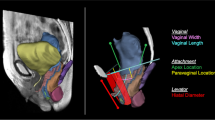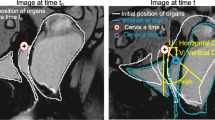Abstract
Introduction and hypothesis
This study seeks to quantify differences in anterior vaginal wall prolapse during sequential Valsalva attempts on dynamic magnetic resonance imaging (MRI).
Methods
Subjects were taken from an on-going case–control study evaluating anterior vaginal wall prolapse. Women with a prolapse whose leading edge extended ≥1 cm beyond the hymenal ring were included (n = 40). All subjects performed three maximal Valsalva efforts while mid-sagittal dynamic MRI scans were obtained. Bladder descent between the first, second, and third maximal Valsalva efforts were compared.
Results
Forty percent of women had a greater than 2-cm increase in prolapse size from their first to third Valsalva attempt. Ninety-five percent of women extended their prolapse further with a third Valsalva.
Conclusions
As is true during clinical examination, several attempts may be required to have maximal anterior compartment prolapse present during dynamic MRI of the pelvic floor.


Similar content being viewed by others
References
Summers A, Winkel LA, Hussain HK, DeLancey JO (2006) The relationship between anterior and apical compartment support. Am J Obstet Gynecol 194(5):1438–1443
Hsu Y, Chen L, Summer A, Ashton-Miller JA, DeLancey JOL (2007) Anterior vaginal wall length and degree of anterior compartment prolapse seen on dynamic MRI. Int Urogynecol J 19(1):137–142
Bump RC, Mattiasson A, Bø K, Brubaker LP, DeLancey JO, Klarskov P, Shull BL, Smith AR (1996) The standardization of terminology of female pelvic organ prolapse and pelvic floor dysfunction. Am J Obstet Gynecol 175(1):10–17
Hsu Y, Summers A, Hussain HK, Guire KE, DeLancey JO (2006) Levator plate angle in women with pelvic organ prolapse compared to women with normal support using dynamic MR imaging. Am J Obstet Gynecol 194(5):1427–1433
Hsu Y, Lewicky-Gaupp C, DeLancey JO (2008) Posterior compartment anatomy as seen in magnetic resonance imaging and 3-dimensional reconstruction from asymptomatic nulliparas. Am J Obstet Gynecol 198(6):651
Chen L, Hsu Y, Ashton-Miller JA, DeLancey JO (2006) Measurement of the pubic portion of the levator ani muscle in women with unilateral defects in 3-D models from MR images. Int J Gynaecol Obstet 92(3):234–241
Cortes E, Reid WM, Singh K, Berger L (2004) Clinical examination and dynamic magnetic resonance imaging in vaginal vault prolapse. Obstet Gynecol 103(1):41–46
Morgan DM, Umek W, Stein T, Hsu Y, Guire K, Delancey JO (2007) Interrater reliability of assessing levator ani muscle defects with magnetic resonance images. Int Urogynecol J Pelvic Floor Dysfunct 18(7):773–778
Lockhart ME, Fielding JR, Richter HE, Brubaker L, Salomon CG, Ye W, Hakim CM, Wai CY, Stolpen AH, Weber AM (2008) Reproducibility of dynamic MR imaging pelvic measurements: a multi-institutional study. Radiology 249(2):534–540
Broekhuis SR, Fütterer JJ, Barentsz JO, Vierhout ME, Kluivers KB (2009) A systematic review of clinical studies on dynamic magnetic resonance imaging of pelvic organ prolapse: the use of reference lines and anatomical landmarks. Int Urogynecol J Pelvic Floor Dysfunct 20(6):721–729, Epub 2009
Woodfield CA, Hampton BS, Sung V, Brody JM (2009) Magnetic resonance imaging of pelvic organ prolapse: comparing pubococcygeal and midpubic lines with clinical staging Int Urogynecol J Pelvic Floor Dysfunct 20(6):695–701, Epub 2009
Handa VL, Lockhart ME, Kenton KS, Bradley CS, Fielding JR, Cundiff GW, Salomon CG, Hakim C, Ye W, Richter HE (2009) Magnetic resonance assessment of pelvic anatomy and pelvic floor disorders after childbirth. Int Urogynecol J Pelvic Floor Dysfunct 20(2):133–139, Epub 2008
Acknowledgments
This research was supported by grants from the National Institute of Health Grants R01 HD 38665 and ORWH P50 HD44406.
Conflicts of interest
None.
Author information
Authors and Affiliations
Corresponding author
Rights and permissions
About this article
Cite this article
Tumbarello, J.A., Hsu, Y., Lewicky-Gaupp, C. et al. Do repetitive Valsalva maneuvers change maximum prolapse on dynamic MRI?. Int Urogynecol J 21, 1247–1251 (2010). https://doi.org/10.1007/s00192-010-1178-1
Received:
Accepted:
Published:
Issue Date:
DOI: https://doi.org/10.1007/s00192-010-1178-1




